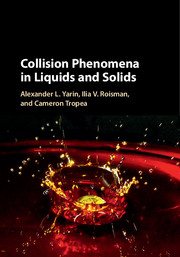Book contents
- Frontmatter
- Contents
- Preface
- 1 Introduction
- 2 Selected Basic Flows and Forces
- Part I Collision of Liquid Jets and Drops with a Dry Solid Wall
- Part II Drop Impacts onto Liquid Surfaces
- 6 Drop Impacts with Liquid Pools and Layers
- Part III Spray Formation and Impact onto Surfaces
- Part IV Collisions of Solid Bodies with Liquid
- Part V Solid–Solid Collisions
- Index
- References
6 - Drop Impacts with Liquid Pools and Layers
from Part II - Drop Impacts onto Liquid Surfaces
Published online by Cambridge University Press: 13 July 2017
- Frontmatter
- Contents
- Preface
- 1 Introduction
- 2 Selected Basic Flows and Forces
- Part I Collision of Liquid Jets and Drops with a Dry Solid Wall
- Part II Drop Impacts onto Liquid Surfaces
- 6 Drop Impacts with Liquid Pools and Layers
- Part III Spray Formation and Impact onto Surfaces
- Part IV Collisions of Solid Bodies with Liquid
- Part V Solid–Solid Collisions
- Index
- References
Summary
In this chapter drop impacts onto a liquid layer of the same liquid as in the drop are considered. The chapter begins with consideration of such weak drop impacts on a liquid layer that they result only in capillary waves propagating over the surface. An interesting feature of these waves is that they are self-similar (Section 6.1). In the following Section 6.2 crown formation in strong (high-velocity) impacts onto thin liquid films is considered. Normal and oblique impacts of a single drop onto a wet wall are studied, as well as crown–crown interaction in sprays impacting the wall. Also, the evolution of the free rim on top of the crown is described. Then, in Section 6.3 drop impacts onto a thick liquid layer are considered and the dynamics of the crater formation is explained. Drop impacts onto a wet wall leave a residual liquid film on the wall which is addressed in Section 6.4. Drop impacts onto deep liquid pools produce a plethora of interesting morphological structures considered in Section 6.5. In the following Section 6.6 bending instability of a free rim is considered and the splashing mechanism is discussed. Splashing resulting from impacts of drop trains one-by-one is discussed in Section 6.7, where its physical mechanism and the link to splashing of a single drop impacting onto a liquid layer are elucidated. Several other regimes of drop impact are also mentioned.
Drop Impact onto Thin Liquid Layer on a Wall: Weak Impacts and Self-similar Capillary Waves
Consider patterns of capillary waves propagating over the free surface of a thin liquid film from the point where it was impacted normally by a tiny droplet or a stick (Fig. 6.1), as an example of a relatively weak (low-velocity) impact. For scales of the order of several millimeters the gravity effect on these waves is negligibly small, and for time scales of the order of several milliseconds viscosity effects can also be neglected.
- Type
- Chapter
- Information
- Collision Phenomena in Liquids and Solids , pp. 255 - 320Publisher: Cambridge University PressPrint publication year: 2017
References
- 1
- Cited by

